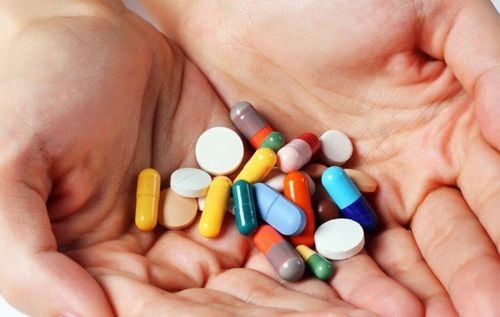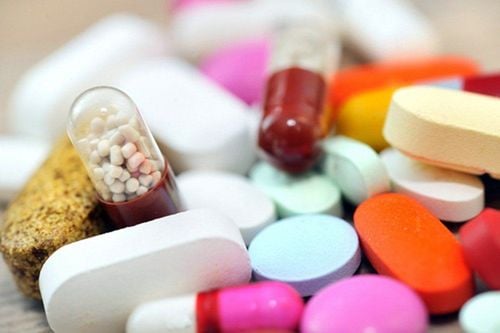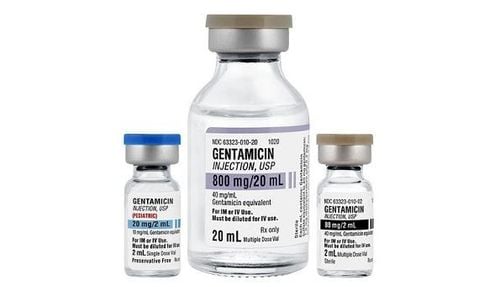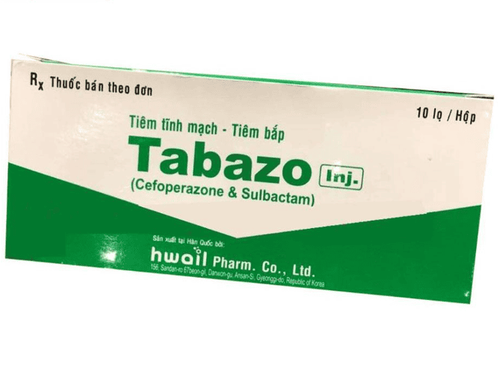This is an automatically translated article.
Ilascin is an antibiotic given by injection to help treat bacterial infections. Ilascin is usually indicated in severe infections and with great caution because of the risk of drug resistance.
1. What is Ilascin?
The main ingredients of the drug Ilascin are Imipenem 500mg and Cilastatin 500mg (as a mixture of Imipenem monohydrate, Cilastatin sodium and Sodium bicarbonate). The dosage form is powder for injection.
Imipenem is a potent beta-lactam antibiotic. Imipenem has antibacterial activity due to its affinity for and binding to most bacterial penicillin-binding proteins (PBPs), including PBPs 1a, 1b, 2, 4, 5 and 6. The drug is involved in the formation of penicillins. Bacterial cell wall, blocking this process should be effective against most gram-negative and gram-positive bacteria, including betalactamase-producing bacteria.
However, because the drug is easily metabolized in the kidney by the enzyme dehydropeptidase I. Therefore, imipenem is often used in combination with cilastatin, an enzyme inhibitor. In fact, cilastatin has no antibacterial effect, but only acts as a protective agent, preventing the antibiotic Imipenem from being hydrolyzed by enzymes and significantly increasing the concentration of intact imipenem in the urinary tract. .
2. Indications and contraindications of the drug Ilascin
Imipenem is a very strong antibacterial drug, but should not be abused. Imipenem is not the drug of first choice but is only used to treat very serious infections where other antibiotics have not been effective.
Ilascin is indicated in the following cases:
Urinary tract infections; Lower respiratory tract infections, hospital-acquired pneumonia; Intra-abdominal and gynecological infections; Skin, soft tissue, bone and joint infections; Biliary tract infections ; Severe infections, mixed infections acquired in the hospital. Severe trauma with multiple lesions accompanied by infection; Bacterial infections in the feet of people with diabetes caused by a mixture of bacteria; Treatment of postoperative infections in the stomach - intestines or female genital tract surgery; Sepsis ; Indicated for use in very severe infections, even when the type of bacteria is not known, or in cases where both anaerobic and aerobic infections are suspected. Treatment of infections caused by mixed bacteria for which other drugs with a narrower spectrum of action are ineffective or are contraindicated due to high toxicity. The drug Ilascin should not be used when:
The patient has a history of hypersensitivity to any component of the drug; Are taking medications containing sodium valproate. Because it lowers the blood level of sodium Valproate and increases the risk of stroke.
3. Dosage and how to take Ilascin
How to use:
Ilascin is administered intravenously. Mix the drug with suitable infusion solutions such as sodium chloride 0.9%, mix with 100ml of sodium chloride solution and be careful not to mix with solutions containing sodium lactate. The infusion rate is dose dependent, ranging from 30 to 60 minutes. It is necessary to monitor the patient during the injection to promptly detect if a convulsion may occur. If nausea and/or vomiting occurs while taking the drug, reduce the infusion rate. Dosage for use in adults:
Moderate infections: Use at a dose of 250 - 500mg, every 6 - 8 hours (1 - 4g/day). Severe life-threatening infections with only moderately susceptible bacteria: Use 1g/time, every 6-8 hours. The maximum daily dose is 4g or 50mg/kg. Children (under 12 years old):
Under 1 week, weighing at least 1500g: 25mg/kg (imipenem component) every 12 hours. Children 1 to 4 weeks, weighing at least 1500g: 25mg/kg (imipenem component) every 8 hours. Children from 4 weeks to 3 months, weighing at least 1500g: 25mg/kg (imipenem component) every 6 hours. Children 3 months and older: 15 to 25 mg/kg (imipenem component) every 6 hours. The maximum dose is 4g/day. In case of renal failure: Dosage is based on creatinine clearance:
Creatinine clearance: From 31 - 70ml/min, 75% of the usual dose is 500mg, 6 - 8 hours apart. Creatinine clearance: From 21-30ml/min, 50% of the usual dose is 500mg, 8-12 hours apart. Creatinine clearance: 6-20ml/min, 25% of the usual dose is 250mg (or 3.5mg/kg) 12 hours apart. Creatinine clearance ≤ 5 ml/min: imipenem should only be given if hemodialysis is started within 48 hours. Take an additional dose after hemodialysis. Patients < 30 kg with renal failure should not prescribe Ilascin. Hepatic impairment and the elderly: No dose adjustment is required. Unless the elderly have impaired renal function.
4. Side effects of Ilascin
When using Ilascin you may encounter the following side effects:
Common: Nausea, vomiting, diarrhea, phlebitis at the injection site. Uncommon: Hypotension, palpitations; seizures, erythema, pseudomembranous colitis; neutropenia (including agranulocytosis), eosinophilia, anemia, thrombocytopenia; increased prothrombin time; increased AST, ALT, alkaline phosphatase and bilirubin; pain at the injection site, increased blood urea and creatinine; Urine test is not normal. Rare: Pseudomembranous colitis; Candida infection; anaphylactoid reactions, encephalopathy; dysesthesia, tremor, change in taste; hearing loss; acute renal failure, causing oliguria or anuria, polyuria, urine discoloration; When taking the drug, if there are any side effects, you should notify your doctor for treatment.
5. Notes when using Ilascin
Some things to keep in mind when taking Ilascin include:
Before treatment, it is advisable to learn carefully about the history of previous hypersensitivity reactions to beta-lactam antibiotics, digestive disorders. When CNS side effects such as myoclonus, confusional state or convulsions have occurred after intravenous administration, the drug dose should be discontinued or reduced. Pregnant women should only use the drug when the infection is serious and the benefit outweighs the risk to the fetus. The drug can pass into breast milk, should be used with caution and it is best to stop breastfeeding during treatment. Children under 12 years of age have not been established for safety, although it has been used for treatment. But when used with extreme caution As with other antibiotics, prolonged use of Ilascin can lead to overgrowth of non-susceptible microorganisms. In particular, pseudomembranous colitis has been reported, so pay attention to those who present with diarrhea before and after taking the drug. Imipenem is a potent antibiotic that should only be used as a weapon against other resistant bacteria and with extreme caution. Because of the risk of drug resistance, it should only be used for severe infections. Drug interactions: Ilascin can interact with other antibiotics, should not be used or mixed for intravenous injection. Drugs lose their activity at alkaline or acidic pH, so care should be taken when choosing a solution for dilution. Ilascin is a strong antibiotic, only prescribed by a qualified doctor. Do not use indiscriminately because if resistant, then choosing antibiotics when treating severe infections is very difficult. If you have any problems while taking this medicine, tell your doctor right away.
Please dial HOTLINE for more information or register for an appointment HERE. Download MyVinmec app to make appointments faster and to manage your bookings easily.













